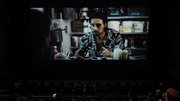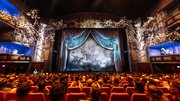Article
Projectors bring Japanese artist's vision to life
When a Silicon Valley art museum was chosen for internationally acclaimed Japanese artist Tabaimo's first solo exhibit in the U.S., which included video animations, its staff needed a way to present the exhibit that would stay true to the artist's vision. It also had to be easy to operate and maintain during the six-month show.

July 15, 2016 by Travis Wagoner — Editor, Networld Media Group
When a Silicon Valley art museum was chosen for internationally acclaimed Japanese artist Tabaimo's first solo exhibit in the U.S., which included video animations, its staff needed a way to present the exhibit that would stay true to the artist's vision. It also had to be easy to operate and maintain during the six-month show, which opened Feb. 6 at the San Jose Museum of Art in San Jose, California.
Tabaimo describes her room-size animations as blurring the line between the real and the surreal, presenting the challenges faced by Japan's so-called "lost generation," caught between the postwar "solidarity" generation and the younger "enlightened" generation. The latter generation, which Tabaimo labeled, "danmen no sedai," tiptoes between past and present, reality and virtual reality, and isolationism and globalism.
In 2015, Tabaimo began talks with the San Jose Museum of Art to determine what her upcoming exhibit, titled "Tabaimo: Her Room," would look like and how it would be set up, including how the animations would be shown.
The challenge
Tabaimo was looking for a solidly built projector that could sync multiple images into one animation and also needed a lens that would let the projector be relatively close to the wall without distorting the images. Her gallery in New York, James Cohan, provided three NEC PA500U projectors for one of her animations, while exhibit curator Rory Padeken was tasked with finding four more projectors for another. The artist specified a different projector for a third animation, which NEC also lent to the gallery.
With the projectors secured, the museum turned its attention to transforming its gallery space into an environment that would complement and enhance the experience for visitors.
The installation
The Tabaimo exhibit included drawings the museum commissioned the artist to create directly on the gallery walls as well as three animations: "danDAN," a video installation with sound, completed in 2009; "yudangami," a four-channel video installation with sound, completed in 2009; and "aitaisei-josei," a single-channel video installation with sound, completed in 2015.
The total exhibit square footage is slightly less than 6,000 square feet, Padeken said, with multiple unique spaces that visitors view during the show.
"The majority of people are not familiar with this artist before they come to the museum, and it's hard to imagine the work before they see it," he said.
The museum renovated its galleries in collaboration with Tabaimo to create three distinct environments for the three main projection pieces to exist in, creating an immersive experience for visitors using sound and video.
After the renovation, Rich Karson, the museum's chief of design and installation, and his team had to configure the projectors' setup in a way that accurately portrayed the artist's vision. This required some creative thinking from the installation team.
For example, "yudangami" utilized four synced NEC PA550W projectors with NP12ZL lenses. The design team hung the four projectors in a semi-circle, mirroring a convex semi-circle wall build-out. The projectors form one side of the circle, and the wall construction forms the other side of the circle.
The team had to measure the exact radius of the circle and triangulate the positions of the projectors before suspending them from the ceiling. The projectors do not hang flat horizontally, but at an angle. Two of them each connect to one Mac Mini, and both computers are synced through Tabaimo's software to play one continuous image.
"It looks like one projection, even though it's coming from four different sources," Karson said. "Syncing projectors is a very tricky type of installation for us to do, as far as the image and how it appears on the wall."
The results
The projectors experienced no issues other than one projector bulb that needed to be changed out — an expected piece of maintenance for the length of the show, Karson said.
"It's been a really positive experience — not just in terms of having the project match our creative vision, but it's always a roll of the dice when we do video installations and have them up for a long time," Karson said. "This show has a six-month run, which puts a lot of wear and tear on any piece of technology, and the team and I have been blown away that we've only needed to change one bulb. That's unheard of. These are incredibly robust machines."
Feedback has been favorable from all sectors. Tabaimo was "incredibly happy" with how the exhibition turned out, according to Karson, and visitors have been very positive as well.
"It's hard to experience [Tabaimo's] work through images, or even moving video," Padeken said. "You need to be in the space to feel how large the animations are, and how they envelope you in this mesmerizing, surreal world. When I take people on tours, they always inquire how many projectors are being used and how they are showing the image, and they're always surprised by the technology of the exhibit in general."
Some of the responses on the gallery comment cards also have mentioned the technology. Carol M. Pizzo, the museum's director of legacy stewardship, said that one card read, "Very surreal with the style of the studio. Love the show, especially 'danDAN.' Video projection is out of this world. Feels like I'm dreaming!"
Photos courtesy of the San Jose Museum of Art.
About Travis Wagoner
Travis Wagoner spent nearly 18 years in education as an alumni relations and communications director, coordinating numerous annual events and writing, editing and producing a quarterly, 72-plus-page magazine. Travis also was a ghostwriter for an insurance firm, writing about the Affordable Care Act. He holds a BA degree in communications/public relations from Xavier University.







